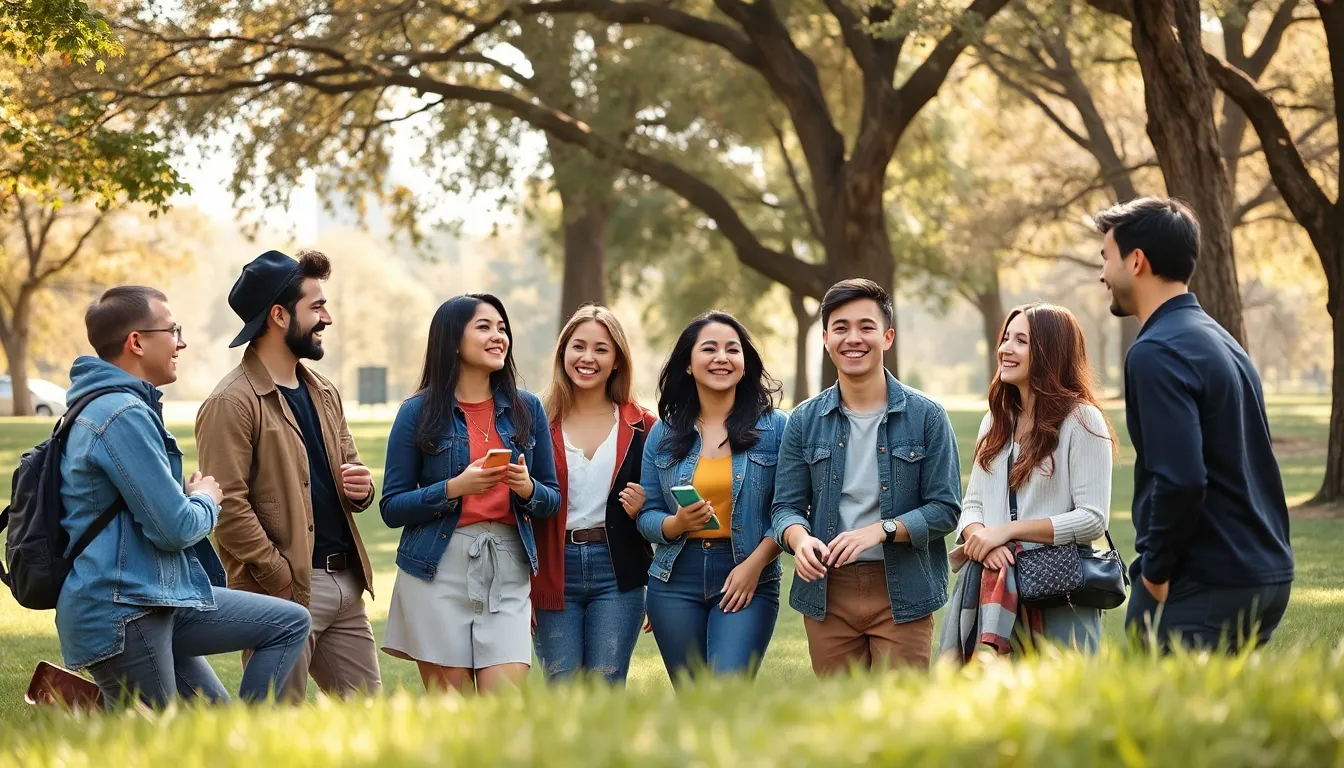Imagine a world where the biggest drama wasn’t a Twitter feud but the latest episode of your favorite sitcom. Life before social media was a simpler time, filled with face-to-face conversations and handwritten notes. People actually looked up from their phones—gasp!—and engaged with the world around them.
Life Before Social Media
Life prior to social media revolved around direct interactions. People nurtured relationships through face-to-face conversations rather than likes and shares. Handwritten notes served as common methods of communication, conveying thoughts and feelings more intimately. Family gatherings and community events thrived, promoting social bonds in a tangible way.
Personal connections fostered a greater sense of belonging, allowing individuals to engage fully with their environment. Phone calls, whether landline or payphone, topped the list of preferred methods to catch up with friends and family. Time spent outdoors, playing games or simply enjoying nature, dominated leisure activities.
The absence of social media provided a slower pace of life, eliminating the pressure of constant online updates. Media consumption varied significantly, as books, newspapers, and television formed primary sources of information. Friendships relied on trust and loyalty, built through shared experiences rather than curated online profiles.
People cherished simpler pleasures, such as visiting a neighbor or receiving a letter in the mail. Many engaged in hobbies like crafting or gardening, nurturing creativity and self-expression without the influence of digital platforms. Conversations ebbed and flowed naturally in a world where silence between words didn’t signify discomfort.
Overall, the period before social media encouraged mindfulness and presence. Choices and experiences shaped identities without the interference of online personas. This era thrived on authenticity, where real-world connections proved crucial for personal satisfaction and happiness.
Daily Communication Methods

Life before social media featured various communication methods that were more personal and direct. People relied on in-person interactions and phone calls, creating connections that felt genuine.
Face-To-Face Interactions
Face-to-face interactions played a crucial role in daily life. Friends gathered at parks, homes, and local events, sharing experiences without screens between them. Conversations flowed naturally, fostering deeper connections. Emotions expressed in person carried more weight than words typed on screens. During family dinners, laughter and storytelling created lasting memories. Social gatherings allowed communities to bond, promoting a sense of belonging. Overall, these direct exchanges cultivated trust and understanding among individuals.
Telephone Conversations
Telephone conversations served as a primary means of long-distance communication. Families used landlines to stay connected, bridging gaps between locations. Calling a friend or relative often led to extended discussions filled with laughter and care. Unlike text messages, voices communicated tone and emotion, making conversations feel more intimate. Scheduling plans typically required a call, leading to anticipation about gatherings. Sharing news or important events over the phone allowed for immediate reactions, enhancing emotional connections. In this era, phones kept relationships alive, even miles apart.
Entertainment Options
Before social media, entertainment options were diverse and personal. They offered individuals a chance to disconnect from daily routines and connect with family and friends.
Television and Movies
Television served as a primary source of entertainment, providing families with shared experiences. Popular shows like “MAS*H” and “Cheers” created cultural touchstones that brought viewers together. Movies became weekend traditions, with theaters showcasing blockbuster hits. Classic films, such as “Star Wars” and “The Godfather,” evoked excitement and prompted discussions long after credits rolled. These experiences fostered family bonding, with parents and children enjoying stories together.
Outdoor Activities
Outdoor activities played a significant role in leisure time. Neighbors gathered for picnics, barbecues, and sporting events, cultivating relationships within communities. Playing games like tag and hide-and-seek kept children active and engaged. Families often went hiking or biking, exploring local parks and trails. Gardening became another popular activity that allowed for communal enjoyment and shared knowledge. Such pursuits encouraged physical activity and promoted a healthier lifestyle without digital distractions.
Information Sources
Information before social media primarily stemmed from traditional media and interpersonal exchanges. People relied heavily on newspapers and magazines to stay informed and entertained.
Newspapers and Magazines
Newspapers served as the backbone of information dissemination. Daily morning editions provided up-to-date news, while weekly magazines offered in-depth articles on various topics. Popular publications like “Time” and “Reader’s Digest” shaped public discourse through feature stories and opinion pieces. Local newspapers connected communities by highlighting regional events and stories. Readers often anticipated Sunday editions, which included special features and puzzles. Magazines covered fashion, health, and lifestyle topics, captivating audiences with vivid imagery and expert interviews. These outlets created a knowledgeable citizenry and initiated discussions about pressing issues in society.
Word of Mouth
Word of mouth played an essential role in communication and information sharing. Neighbors discussed local happenings over fences, fostering community ties. Friends exchanged stories during casual meetups, enriching personal connections through shared experiences. Families relayed news and gossip during dinner, creating a sense of belonging. Significant events often spread through conversations, reinforcing social bonds and ensuring everyone stayed informed. Gathering at social events allowed participants to share insights and opinions openly. This organic method of communication encouraged relationship-building and reinforced community solidarity.
Impact on Relationships
Relationships thrived in a time before social media, where personal connections flourished through direct interactions.
Family Connections
Family gatherings cultivated strong emotional ties. Sharing meals and celebrating holidays reinforced connections in meaningful ways. Everyone looked forward to these occasions, where laughter and stories created lasting memories. Taking time to communicate via phone calls allowed family members to hear each other’s voices, creating a sense of closeness. Handwritten letters also added a personal touch, conveying thoughts and feelings that electronic messages often lack. This intimate exchange built trust and understanding within families, making every member feel valued.
Friendships and Social Circles
Friendships developed through shared experiences and face-to-face interactions. Meeting in parks or homes provided opportunities for deeper bonds to form. Games, outdoor activities, and neighborhood events fostered a sense of camaraderie that formed lasting connections. Conversations held over coffee or during walks strengthened ties among friends. Maintaining relationships relied on direct communication rather than curated online personas. Supportive friendships created a solid foundation, enhancing trust within social circles and promoting a sense of belonging.
Conclusion
Reflecting on life before social media reveals a world rich in genuine connections and meaningful interactions. People engaged with one another face-to-face, nurturing relationships through shared experiences and heartfelt conversations. This simpler time fostered creativity and mindfulness, encouraging individuals to immerse themselves in their surroundings.
Without the distractions of digital platforms, families and friends built lasting memories through outdoor activities and community events. The slower pace of life allowed for deeper emotional ties and a sense of belonging that often feels elusive today. As society navigates the complexities of modern communication, the essence of those earlier connections serves as a reminder of the value of authentic relationships and the joy of being present in the moment.



